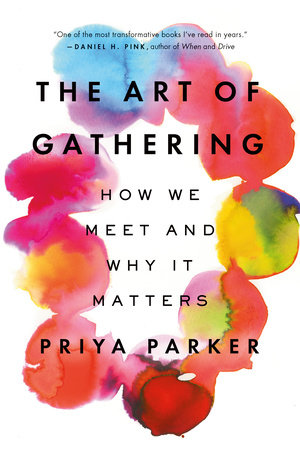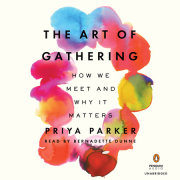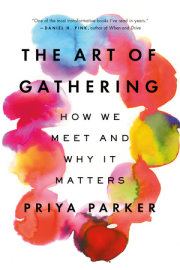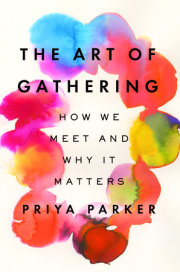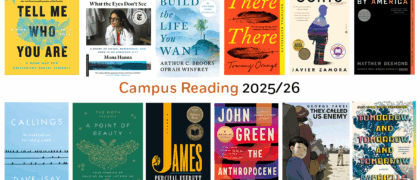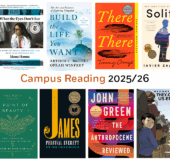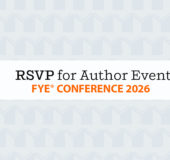The way we gather matters. Gatherings consume our days and help determine the kind of world we live in, in both our inti- mate and public realms. Gathering—the conscious bringing together of people for a reason—shapes the way we think, feel, and make sense of our world. Lawgivers have understood, perhaps as well as anyone, the power inherent in gatherings. In democracies, the freedom to assemble is one of the foundational rights granted to every individual. In countries descending into authoritarianism, one of the first things to go is the right to assemble. Why? Because of what can happen when people come together, exchange information, inspire one another, test out new ways of being together. And yet most of us spend very little time thinking about the actual ways in which we gather.
We spend our lives gathering—first in our families, then in neighborhoods and playgroups, schools and churches, and then in meetings, weddings, town halls, conferences, birthday parties, product launches, board meetings, class and family reunions, dinner parties, trade fairs, and funerals. And we spend much of that time in uninspiring, underwhelming moments that fail to capture us, change us in any way, or connect us to one another.
Any number of studies support a notion that’s obvious to many of us: Much of the time we spend in gatherings with other people disappoints us. “With the occasional exception, my mood in conferences usually swings between boredom, despair, and rage,” Duncan Green, a blogger and specialist in international development, confesses in the
Guardian. Green’s take isn’t unique to conferences: The 2015
State of Enterprise Work survey found that “wasteful meetings” were employees’ top obstacle to getting work done.
We don’t even seem to be thrilled with the time we spend with our friends. A 2013 study,
The State of Friendship in America 2013: A Crisis of Confidence, found that 75 percent of respondent were unsatisfied with those relationships. Meanwhile, in
How We Gather, a recent report on the spiritual life of young people, Angie Thurston and Casper ter Kuile write, “As traditional religion struggles to attract young people, millennials are looking elsewhere with increasing urgency.”
As much as our gatherings disappoint us, though, we tend to keep gathering in the same tired ways. Most of us remain on autopilot when we bring people together, following stale formulas, hoping that the chemistry of a good meeting, conference, or party will somehow take care of itself, that thrilling results will magically emerge from the usual staid inputs. It is almost always a vain hope.
When we do seek out gathering advice, we almost always turn to those who are focused on the mechanics of gathering: chefs, etiquette experts, floral artists, event planners. By doing so, we inadvertently shrink a human challenge down to a logistical one. We reduce the question of what to do with people to a question of what to do about things: PowerPoints, invitations, AV equipment, cutlery, refreshments. We are tempted to focus on the “stuff” of gatherings because we believe those are the only details we can control. I believe that’s both shortsighted and a misunderstanding about what actually makes a group connect and a gathering matter.
I come to gatherings not as a chef or an event planner, but as someone trained in group dialogue and conflict resolution. I’ve spent much of the past fifteen years of my life studying, designing, and advising gatherings whose goals were to be transformative for the people involved and the communities they were trying to affect. Today I work as a professional facilitator. Though there are many of us around, you may have never heard of us. A facilitator is someone trained in the skill of shaping group dynamics and collective conversations. My job is to put the right people in a room and help them to collectively think, dream, argue, heal, envision, trust, and connect for a specific larger purpose. My lens on gathering—and the lens I want to share with you—places people and what happens between them at the center of every coming together.
In my work, I strive to help people experience a sense of belonging. This probably has something to do with the fact that I have spent my own life trying to figure out where and to whom
I belong. I come on my mother’s side from Indian cow worshippers in Varanasi, an ancient city known as the spiritual center of India, and on my father’s side from American cow slaughterers in South Dakota. To cut a very long story short, my parents met in Iowa, fell in love, married, had me in Zimbabwe, worked in fishing villages across Africa and Asia, fell out of love, divorced in Virginia, and went their separate ways. Both of them went on to remarry, finding spouses more of their own world and worldview. After the divorce, I moved every two weeks between my mother’s and father’s households—toggling back and forth between a vegetarian, liberal, incense-filled, Buddhist-Hindu-New Age universe and a meat-eating, conservative, twice-a-week-churchgoing, evangelical Christian realm. So it was perhaps inevitable that I ended up in the field of conflict resolution.
I discovered that field in college when I became interested in, and anguished by, the state of race relations at the University of Virginia. Upon graduating, I worked in communities—in the United States and abroad—to train leaders in a group dialogue process called Sustained Dialogue. It is a gathering technique that aims to transform fractured relationships across racial, ethnic, and religious lines. Through that work, I became fascinated with what occurs when people attempt to come together across difference.
In the years since, I have applied the methods of conflict resolution in a variety of settings and to a great variety of problems. I’ve run meetings in five-star hotels, in public parks, on dirt floors, and in college dorm rooms. I’ve led sessions with villagers in western India grappling with how to rebuild their community after ethnic riots and with Zimbabwean activists fighting the threat of a government shutdown of their NGOs. I’ve worked on dialogues between Arab opposition leaders and their European and American counterparts to explore the relationship between Islam and democracy. I’ve designed gatherings for state and federal officials in the United States to figure out how to revitalize a national poverty program for a new generation. I’ve facilitated gatherings for technology companies, architecture firms, beauty brands, and financial institutions, helping them hold complicated, difficult discussions about their future.
I live in New York City, where people gather a lot. I am often a host and often a guest, and in both roles I am endlessly intrigued by the small and important interventions we can all make to help groups gel. Among my friends and relatives, I am the person people text or call with questions like “Should my work dinner have a guided conversation around a question, or should we just let people chat?” and “How should we handle the one blabbermouth church volunteer?” How, a half-Muslim, half-Christian immigrant friend asked me, might she come up with her own version of a Jewish shiva to mark the death of her father in Germany with friends in New York who never knew him?
In all my gatherings, whether a board meeting or a birthday party, I have come to believe that it is the
way a group is gathered that determines what happens in it and how successful it is, the little design choices you can make to help your gathering soar. So
The Art of Gathering is part journey and part guidebook. It is for anyone who has ever wondered how to take an ordinary moment with others and make it unforgettable—and meaningful.
My hope is that this book will help you
think differently about your gatherings. I have organized the chapters to reflect the sequence that I walk my clients and friends through, and that I employ myself, when designing a meaningful event. Though there are certainly some principles that I believe apply to even the simplest of gatherings, you need not follow every suggestion or step in this book. You are the best person to decide what will be helpful for you and what makes sense in the context of your gatherings.
This book is based on my own experience and ideas, both what I know has worked and what I know hasn’t. Yet because gathering is inherently a collective endeavor, I’ve also interviewed more than one hundred other gatherers to learn their secrets and test my own ideas. My conversations with conference organizers, event planners, circus choreographers, Quaker meeting clerks, camp counselors, funeral directors, DJs, auctioneers, competitive wingsuit flying-formation instructors, rabbis, coaches, choir conductors, performance artists, comedians, game designers, Japanese tea ceremony masters, TV directors, professional photographers, family wealth advisers, and fundraisers have all informed the ideas here. I intentionally draw from a wide variety of gatherings—museums, classrooms, partner meetings, birthday parties, summer camps, and even funerals—to illustrate the creativity that people use regardless of the context, and I hope it inspires you to do the same. All the stories that follow are true, though I have changed some identifying names, details, and locations of events and people for private gatherings. Among the variety of people I spoke with, they all shared one crucial trait: a fascination with what
happens when people come together.
As I send you off into these pages, let me declare my bias up front:
I believe that everyone has the ability to gather well.
You don’t have to be an extrovert. In fact, some of the best gatherers I know suffer from social anxiety.
You don’t need to be a boss or a manager. You don’t need a fancy house.
The art of gathering, fortunately, doesn’t rest on your charisma or the quality of your jokes. (I would be in trouble if it did.)
Gatherings crackle and flourish when real thought goes into them, when (often invisible) structure is baked into them, and when a host has the curiosity, willingness, and generosity of spirit to try.
Let’s begin.
Copyright © 2018 by Priya Parker. All rights reserved. No part of this excerpt may be reproduced or reprinted without permission in writing from the publisher.

